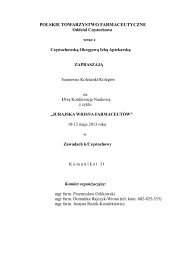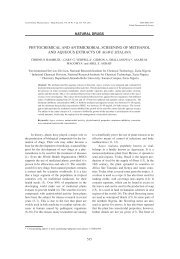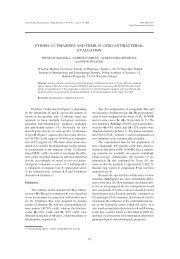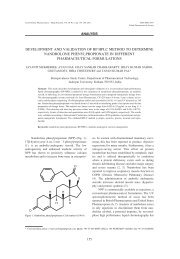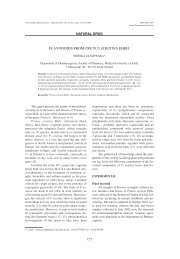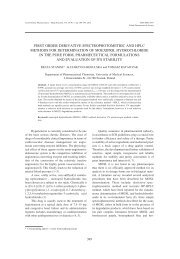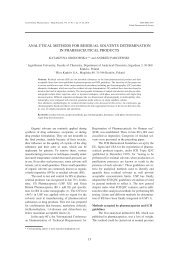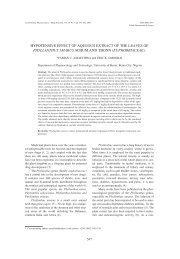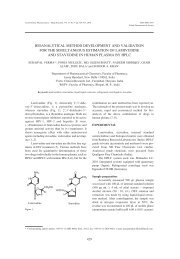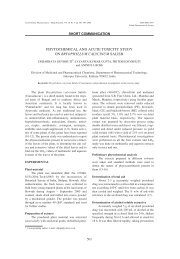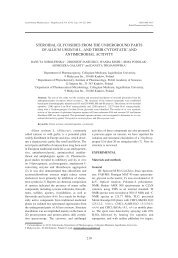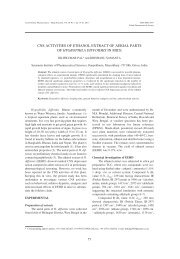CYTOTOXIC EFFECT OF SOME MEDICINAL PLANTS FROM ...
CYTOTOXIC EFFECT OF SOME MEDICINAL PLANTS FROM ...
CYTOTOXIC EFFECT OF SOME MEDICINAL PLANTS FROM ...
Create successful ePaper yourself
Turn your PDF publications into a flip-book with our unique Google optimized e-Paper software.
Cytotoxic effect of some medicinal plants from Asteraceae family... 267<br />
Figure 3. Correlation between total polyphenol content [mg gallic acid equivalents/g dried extract ñ columns] and antileukemic properties<br />
ñ IC 50 value [mg/mL ñ points].<br />
er than after 4 h. Approximately 10-fold increase<br />
was observed for the inflorescences of Calendula<br />
officinalis, Tragopogon pratensis and Centaurea<br />
cyanus. A very large jump (more than 30 times) of<br />
the amount of late apoptotic and necrotic cells in<br />
culture is distinguished for the extract from the herb<br />
Tanacetum vulgare (2.7% after 4 h and 82.5% after<br />
48 h) (Fig. 2E). Over 20-fold increase was observed<br />
for the herb of Artemisia absinthium (Fig. 2B). It is<br />
noted, that all extracts from the roots are characterized<br />
by the similar number of cells in the early<br />
stages of apoptosis (30.45ñ38.85%), weakly<br />
depending on time. In J-45.01 culture, after 48 h of<br />
stimulation, extracts from inflorescences of<br />
Tragopogon pratensis caused a very large drop in the<br />
number of viable cells (89%) compared to the reading<br />
at 4 h (Fig. 2F). For the roots of Artemisia<br />
absinthium, Calendula officinalis, Tanacetum vulgare<br />
and Tragopogon pratensis, after 48 h, a similar<br />
number of live cells and cells in the early stages of<br />
apoptosis (about 40%) was found in all test. Indeed,<br />
the apoptotic cells (compaction and margination of<br />
nuclear chromatin, cytoplasmic condensation and<br />
membrane blebbing and cell shrinkage) were<br />
observed.<br />
In the next stage of investigations, the total<br />
content of polyphenol compounds was detected<br />
according to the Singleton and Rossi method. The<br />
highest content of polyphenol compounds among all<br />
tested extracts (inflorescence, herbs and roots) was<br />
found for Tanacetum vulgare (39.39, 30.42 and 24<br />
mg/g gallic acid, respectively) (Table 1). High level<br />
of polyphenols was recorded also in the inflorescences<br />
of Tragopogon pratensis (35.41 mg/g gallic<br />
acid) and it is similar to the total phenolic content<br />
examined for the aerial parts (leaves and flowers)<br />
for the other Tragopogon species: T. budjnurdense,<br />
T. hololeucum, T. chiliophyllum, T. sonboli, T.<br />
tabrisianum and T. kotschyi (32.15, 47.11, 37.24,<br />
32.60, 28.90 and 44.40 mg/g gallic acid, respectively)<br />
(27). Quite high amount of polyphenol compounds<br />
was also detected in roots and herbs of<br />
Arctium lappa (23.50 and 22.93 mg/g gallic acid)<br />
and herbs of Artemisia absinthium (22.36 mg/g gallic<br />
acid).<br />
For evaluation of relationship between<br />
antileukemic activity and the total content of<br />
polyphenol compounds in the studied extracts, the<br />
MS Excel spreadsheet and statistic program<br />
GraphPad In Stat3 were used. Graphical comparison<br />
of the results showed a clear positive relationship<br />
between the highest polyphenol content and the<br />
strongest cytotoxicity (low IC 50 value) only for the<br />
inflorescences of Tanacetum vulgare (Fig. 3). The<br />
opposite correlation (small polyphenol content and<br />
weak antileukemic properties) was observed for the<br />
roots of Artemisia absinthium and Tragopogon<br />
pratensis. According to GraphPad In Stat3, p-values<br />
of less than 0.05 were considered significant.<br />
In conclusion, the screening of plant extracts<br />
for their cytotoxic and apoptotic properties has<br />
shown that medicinal herbs from Asteraceae family<br />
might have also antileukemic importance.<br />
REFERENCES<br />
1. Arino A., Arberas I., Renobales G., DomÌnguez<br />
J.B.: Eur. Food Technol. 209, 126 (1999).<br />
2. Setzer W.N., Vogler B., Schmidt J.M., Leahy<br />
J.G., Rives R.: Fitoterapia 75, 192 (2004).



